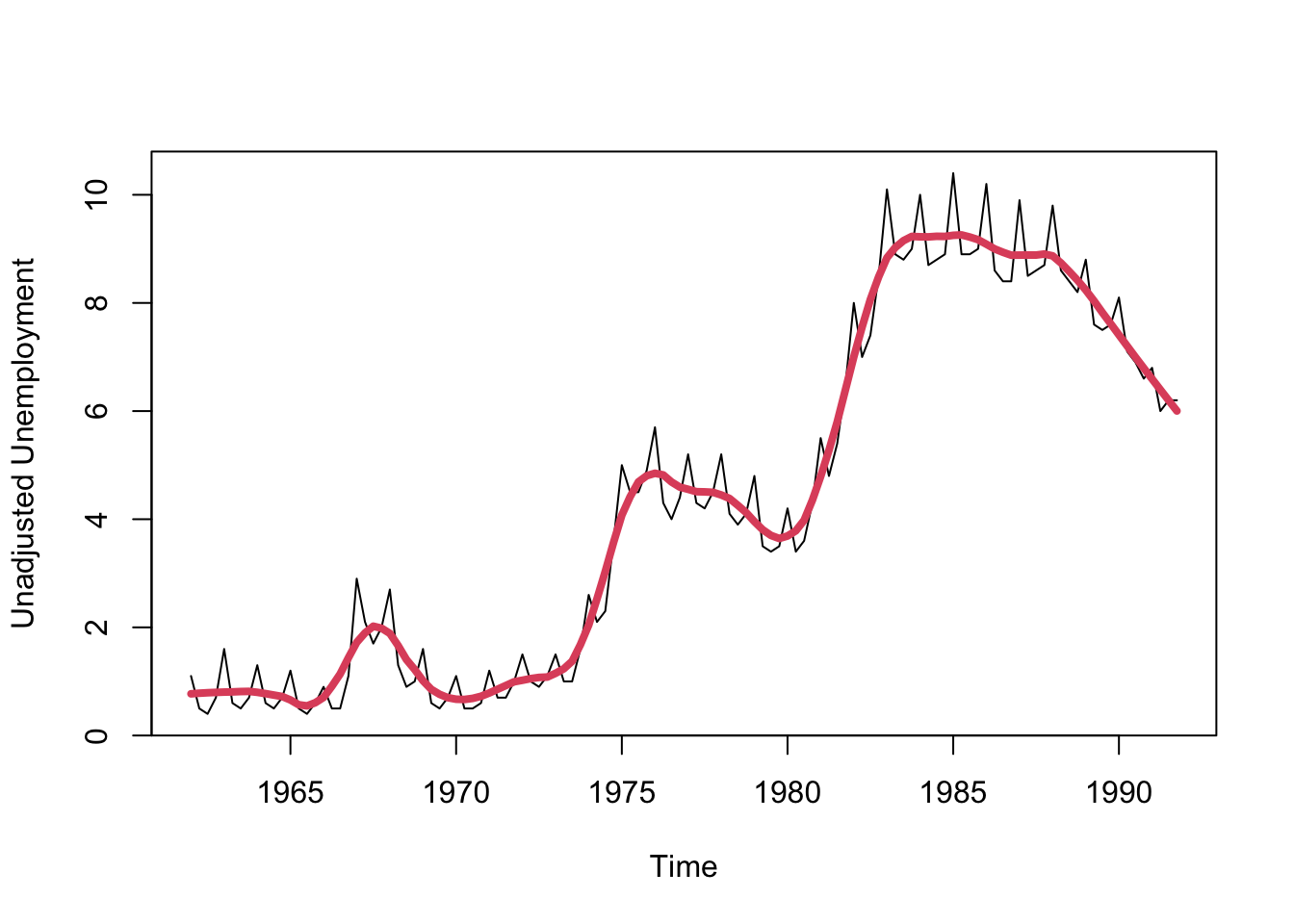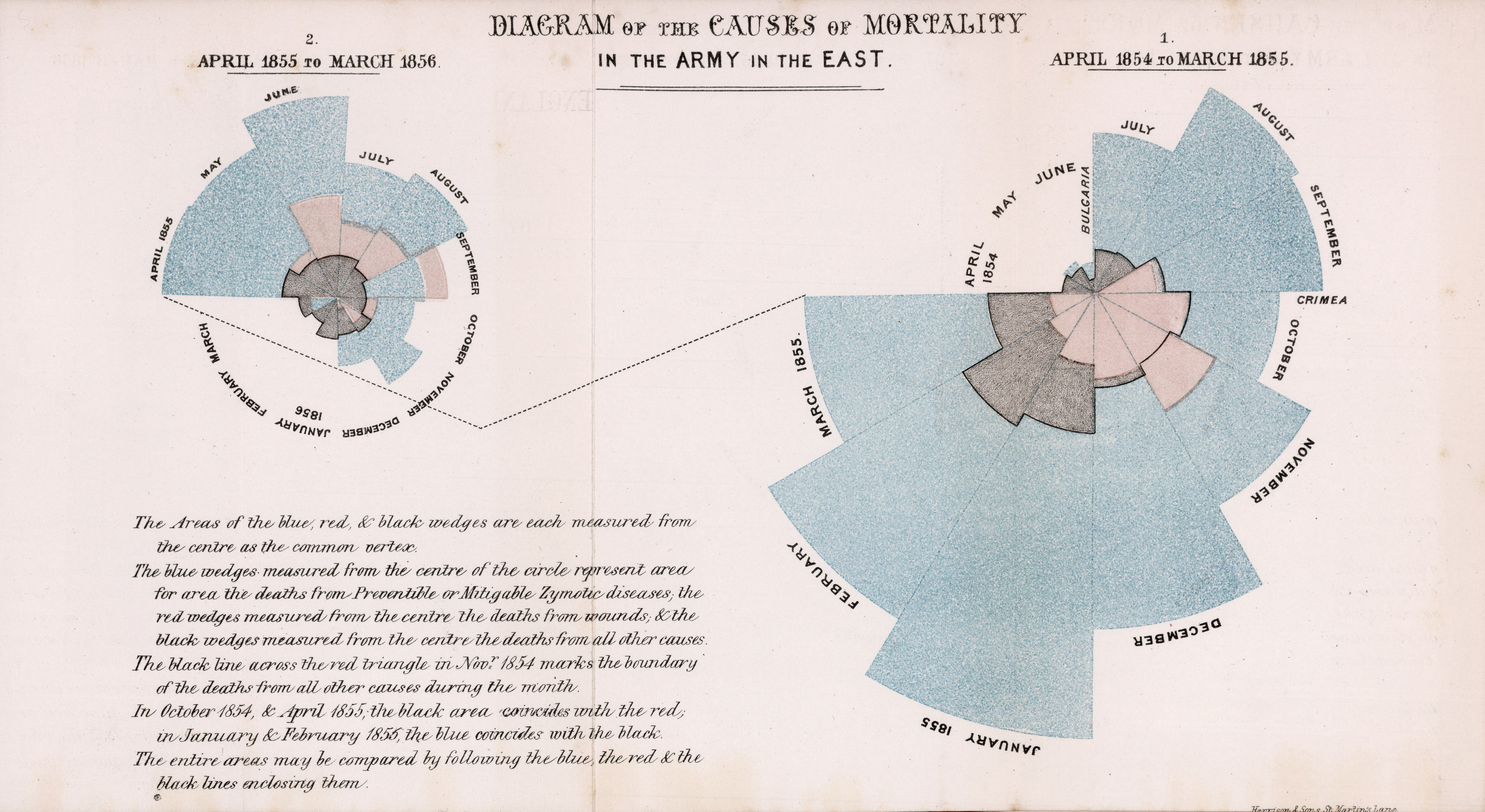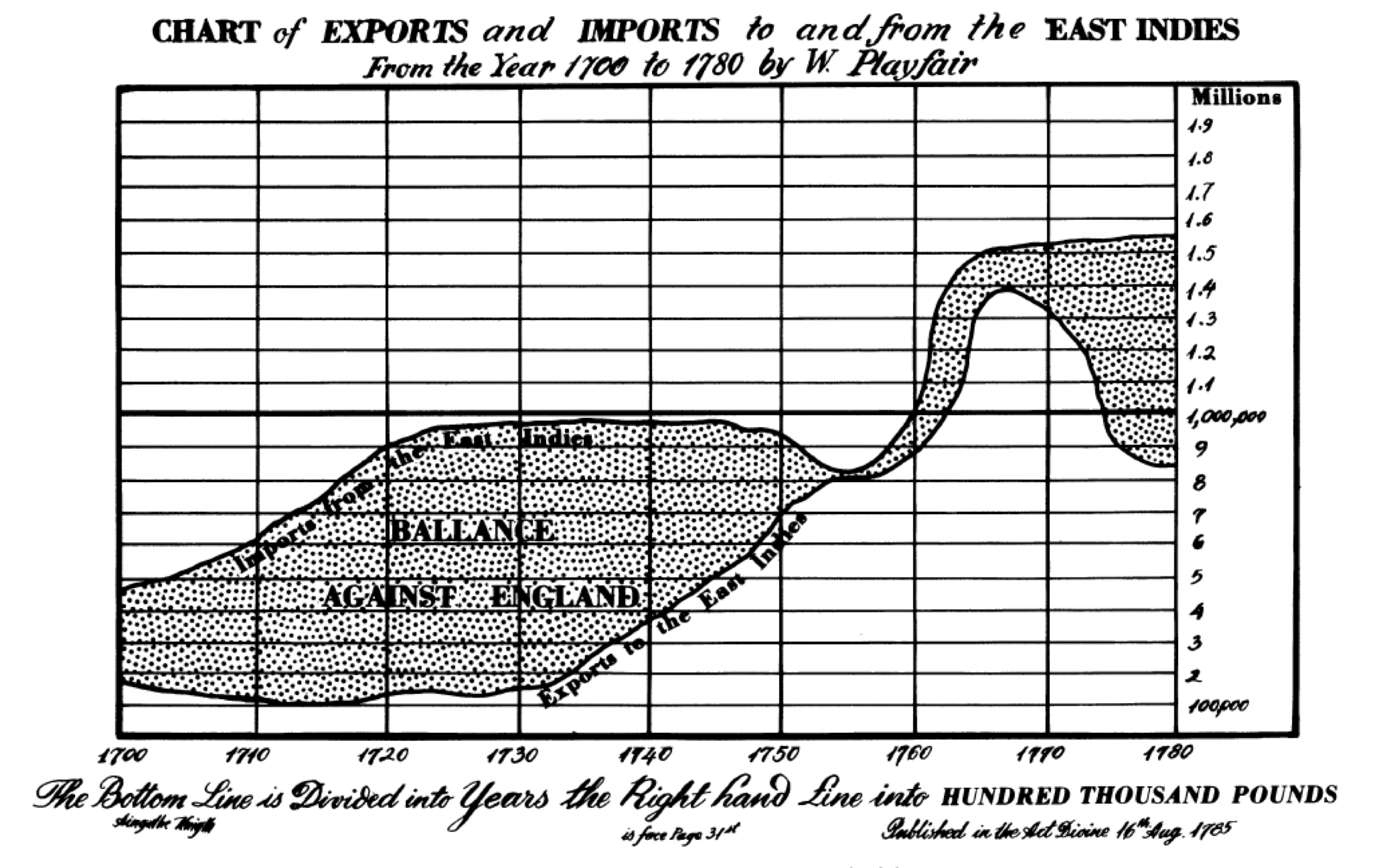Lecture 10 - Exploring Time Series
1 Exploring Time Series
- A time series is a sequence of repeated observations of a particular variable over time.
- The US opinion poll data is an example of a time series.
- Unlike a regular variable, observations of a time series are not independent.
- Time series analysis is a whole subject within statistics, but we won’t be going into that.
- Visualising time series is relatively simple - if we observe \(y_i\) at time \(t_i\), then we simply plot the pairs \((y_i,t_i)\) on a scatterplot and often then join the points by lines.
- It is common to add a trend estimate using some form of smoothing.
- Multiple time series of the same variable can be stacked or standardised.
Features to look for:
- An overall trend or pattern of behaviour over time (or lack thereof)
- Presence of regular patterns of behaviour around the trend
- Any changes in or deviations from the trend
- Similarities and differences between:
- Different but related series for the same population
- The same series for different sub-groups
The key thing to remember is that the observations of a time series
are not independent! So, looking at one-variable summaries can be
misleading – the most important feature is how things behave over
time. For instance, consider this data on the population of lynxes
over time. If we ignore the time aspect, then the data look like this
 But by explicitly including time in the visualisation, we radically
change what we can learn.
But by explicitly including time in the visualisation, we radically
change what we can learn.
 We can see there are cyclical changes in the populations, with regular
peaks and troughs in the population numbers. All of this is lost if we
forget about the dependence on time.
We can see there are cyclical changes in the populations, with regular
peaks and troughs in the population numbers. All of this is lost if we
forget about the dependence on time.
To plot data using connected lines, we can use the same
plot function as for scatterplots, but add the
ty argument with value l for
line. Alternatively, if the time series is relatively
short, we can use b instead to show both lines
and points. Another option is s for steps.
Note also that when drawing time series we prefer to join our points by lines. As these quantities evolve over time, it is natural to connect the points to indicate the transition from time point to time point. Usually, we default to connecting points with straight lines, but smoothers or other curves can also be used.
1.1 Example: US Savings rate
Time series of financial variables are very often noisy and highly variable. The plot below shows the US Personal Savings Rate over time.
load('economics.Rda')
plot(x=economics$date, y=economics$psavert, ty='l', xlab='Date', ylab='Personal Savings Rate')
There are signs of a global trend to these data, which slowly evolves over time. However, separating the ‘trend’ from ‘noise’ is difficult. Additionally, there is no clear regular patterns to observe like with the lynx data. One approach to unpacking the behaviour of time series data is to apply smoothing techniques with different bandwidths.
A long bandwidth smoother could identify a trend such as the red line below. A smoother with a narrower bandwidth could detect some of the smaller variations around that trend, such as the green line. However there is plenty of residual variation that is still unexplained!
## create some times to predict the curve at
xs <- seq(min(as.numeric(economics$date)), max(as.numeric(economics$date)), length=200)
## fit the model, note we have to convert our 'date' to numbers here
lfit1 <- loess(psavert~as.numeric(date), data=economics)
## predict
lpred1 <- predict(lfit1, data.frame(date=xs), se = TRUE)
## same again, with smaller span
lfit2 <- loess(psavert~as.numeric(date), data=economics, span=0.1)
lpred2 <- predict(lfit2, data.frame(date=xs), se = TRUE)
## draw the plot
plot(x=economics$date, y=economics$psavert, xlab='Date',ylab='Personal Savings Rate', ty='l')
lines(x=xs, y=lpred1$fit, col='red',lwd=4)
lines(x=xs, y=lpred2$fit, col='green',lwd=4) 
2 Time series components
It is often useful to think of a time series as being made up of multiple components:
- A trend - which describes the ‘big picture’ behaviour of the data over time
- Seasonal effects - which describes predictable behaviour around the trend. This is often periodic, though not all time series exhibit seasonal effects.
- Residuals - which are the random noise left over.
The time series is then thought of has a sum of these terms: \[Y_t=T_t+S_t+\epsilon_t.\]
Sometimes, time series also incorporate an ‘irregular’ component to represent non-seasonal departures from the trend.
Our example above could have a trend described by the red line. The green line doesn’t have a regular periodic behaviour - i.e. a regular pattern that repeats - so this would probably be the irregular component. The remaining noise of the data as indicated by the deviations of the black lines from the green would then constitute the residuals.
2.0.1 Example: German Unemployment Figures
The figure below shows the unadjusted quartery (West) German unemployment rates from 1961 to just after the unification of the two Germanies.
library(AER)## Loading required package: car## Loading required package: carData##
## Attaching package: 'carData'## The following object is masked _by_ '.GlobalEnv':
##
## UN##
## Attaching package: 'car'## The following object is masked from 'package:psych':
##
## logit## Loading required package: lmtest## Loading required package: zoo##
## Attaching package: 'zoo'## The following objects are masked from 'package:base':
##
## as.Date, as.Date.numeric## Loading required package: sandwich## Loading required package: survivaldata(GermanUnemployment)
ts <- seq(1962,1991.75,by=0.25)
geu <- data.frame(GermanUnemployment)$unadjusted
plot(geu ~ts,ty='l',xlab='Time',ylab='Unadjusted Unemployment') Unemployment was very low in the 60s and 70s, apart from a short spell
in 1967. There were distinct jumps in unemployment in the mid 70s and
early 80s due to the oil crises of 1973 and 1979. Unemployment was
declining at the end of the series from the high levels in the 1980s.
The series shows strong but regular variation around the trend
corresponding to higher levels in winter than in summer.
Unemployment was very low in the 60s and 70s, apart from a short spell
in 1967. There were distinct jumps in unemployment in the mid 70s and
early 80s due to the oil crises of 1973 and 1979. Unemployment was
declining at the end of the series from the high levels in the 1980s.
The series shows strong but regular variation around the trend
corresponding to higher levels in winter than in summer.
The smoothing methods we’ve seen are particularly effective in extracting a smooth trend from the data:

We can then take our trend and subtract it from the time series. What’s left over will be the seasonal component plus the residuals!
res <- geu - lpred$fit
plot(x=ts, y=res,col=3,lwd=2,ty='l',xlab='Time',ylab='Residual')
abline(h=0)
The seasonal pattern here is regular, with peaks and troughs occuring at regular intervals.
We can extract the time series components by hand by doing
loess smooths of the data with different bandwidths.
However, R can do most of this for us:
geu <- ts(GermanUnemployment[,1], ## Need to turn the data to a time series object
frequency=4) # Four observations per year defines the frequency of the regular pattern
decomp <- stl(geu, s.window = "periodic") ## pass `periodic` to seek a periodic seasonal component
plot(decomp)
The results of the decomposition are shown in the various panels of the plot. The top panel gives the original data, the second panel shows the periodic seasonal component, the third panel shows the general trend, and the bottom panel shows the residuals leftover at the end.
3 Graphics for multiple time series
Depending on what time serieswe’re showing, there are a number of things to consider:
- Related series for the same population - if possible, show the different time series within the same plot to ease comparison. Be careful of units!
- Series for different subgroups - showing subgroups together helps draw comparisons. Are we interested in the values or the proportions of the subgroups?
- Series with different scales - may need standardising to a common scale to show together, otherwise separate plots will be needed.
3.1 Example: Florence Nightingale and Crimean War deaths
Florence Nightingale famously used data and visualisations to highlight the poor conditions of soldiers in field hospitals during the Crimean War (1854-6). While certainly more well-known as a nurse, she was also a statistician and the first female member of the Royal Statistical Society. She used data visualisations to highlight the causes of mortality of soliders in field hospitals during the Crimean War (1854-6).

While this is not a plot we would recognise today, it is a time series represented in polar form like a pie chart. The colours represent the different sources of mortality, and the segments represent sequential observations. Unwrapping this as a more conventional plot gives the more readable form:

Plotting the annualised monthly death rates from disease, wounds, and other causes makes her case clearly. The death rate from diseases (black) due to poor conditions far outstrips the deaths due to injury sustained in combat (red). The most dangerous conflicts occured at the end of 1854, but even then the number of lives lost was dwarfed by deaths from disease.
4 Comparing Time Series
The simplest way to compare time series is to show them simultaneously on the same plot.
As an example, William Playfair graphed England’s trade to the East Indies in the 18th century. Let’s revisit this plot:

A more modern version would look something like this:
library(GDAdata)##
## Attaching package: 'GDAdata'## The following object is masked _by_ '.GlobalEnv':
##
## uniranksdata(EastIndiesTrade)
plot(x=EastIndiesTrade$Year,y=EastIndiesTrade$Imports, col=2, xlab='Year',
ylab='Exports (blue) and Imports (red)', lwd=4,ty='l',ylim=c(0,2000))
lines(x=EastIndiesTrade$Year,y=EastIndiesTrade$Exports,col=4,lwd=4)
library(scales)##
## Attaching package: 'scales'## The following objects are masked from 'package:psych':
##
## alpha, rescalepolygon(x=c(EastIndiesTrade$Year,rev(EastIndiesTrade$Year)),
y=c(EastIndiesTrade$Imports,rev(EastIndiesTrade$Exports)),
col=scales::alpha('green',0.25),border=NA)
As the time series were recorded for the same time points, we can directly calculate differences, and show the trade deficit. The line \(y=0\) is significant as it indicates whether we’re in deficit or surplus, so we can add that for reference.
plot(x=EastIndiesTrade$Year,y=(EastIndiesTrade$Exports-EastIndiesTrade$Imports), col='green2', xlab='Year',
ylab='Exports - Imports', lwd=4,ty='l')
abline(h=0,col=2)
Many of the features can be associated with major events of the time: the War of Spanish Succession, 1701-14; the South Sea Bubble, 1720; the Seven Year’s War, 1756-63; and the American Revolutionary War, 1775-83. However, it would be rather harder to identify these from the original.
4.2 Issues with Time Series
- Length of time series - not all time series will have data for the same period. Are we interested in the long-term or short-term features?
- Irregular vs regular series - time series data may not be recorded on a regular schedule, making detection or exploitation of periodic behaviour difficult. Similarly, where we have multiple time series they may not be all recorded at the same times, making direct comparisons difficult
- Data definitions may change - for long-term time series, the definition of the variable may change during the series, e.g. definitions of unemployment, GDP, net migration etc can change which makes comparison difficult.
- Time series of discrete variables - barcharts may be better for ordinal variables, but categorical variables may be best illustrated by the observed proportions of the different categories. Alternatively, Sankey plots can be used to display how proportions of a categorical variable change.
- Outliers - as usual, be careful with outliers but be mindful that they may be part of the pattern over time, e.g. peaks of the coronavirus epidemic.
4.3 Issues with Time Series
- Length of time series - not all time series will have data for the same period, making comparisons difficult. We should also think about whether we are interested in the long-term behaviour (trend) or short-term features?
- Irregular vs regular series - multiple time series may not be all recorded at the same time points, again making direct comparisons difficult
- Data definitions may change - for long-term time series, the definition of the variable may change during the series. The UK changed its definition of unemployment over 20 times duringfrom 1979 to 1993!
- Time series of discrete variables - barcharts may be better for ordinal variables, but categorical variables may be best illustrated by the observed proportions of the different categories.
- Outliers - be careful with outliers, as they may be part of the pattern over time
5 Summary
- Smoothing is an effective technique for estimating a trend of a data set without requiring complex modelling.
- Kernel density estimation does a similar job for estimating the density function of a variable.
- Both techniques are sensitive to their kernel function, and bandwidth parameter.
- Time series are a special kind of data representing a variable changing over time, and smoothing can be useful to expose the trend.
- Simple line plots are effective for time series, but plotting multiple time series simultaneously needs to be done with care.
6 Conclusion
Exploratory Data Analysis should always be our first look at the data, with the goals to
- better understand the data set and the variables in it;
- uncover underlying structure;
- identify important variables;
- detect outliers and anomalies;
- suggest hypotheses, models, and subsequent statistical investigations.
We have focussed on using graphical methods to try and answer questions with the data (GDA). When performing GDA:
- Use graphics to discover information that is difficult to investigate statistically
- Draw many graphics and vary the graphics options
- Use the graphic types you know well, and practice using them to gain experience in interpreting what they say
- Make appropriate comparisons, and choose appropriate scales
- Statistics and graphics complement each other. Use graphics to suggest statistical approaches, and test any assumptions.
- The context of the data is essential in interpreting what you find.
“The simple graph has brought more information to the data analyst’s mind than any other device.” – John Tukey








